Planning a trip to Mexico? Want to ensure your safety from the country’s most dangerous snakes? Look no further! In this article, we’ll take you on a journey through the treacherous world of Mexico’s deadliest serpents.
From venomous pit vipers like the Querétaro dusky rattlesnake and the Banded rock rattlesnake, to the highly lethal coral snake, we’ll explore their habitats, venomous properties, and behaviors.
But that’s not all, we’ll also uncover the fer-de-lance, a menacing snake known for its aggression and hemotoxic venom. And there’s more – the elusive yellow-bellied sea snake, the twin-spotted rattlesnake, and the Mojave green, all capable of inflicting serious harm.
So, if you’re an adventurer, a nature enthusiast, or simply curious about these fascinating creatures, join us as we unlock the secrets of Mexico’s most dangerous snakes and equip you with the knowledge to stay safe in their presence.
Querétaro Dusky Rattlesnake
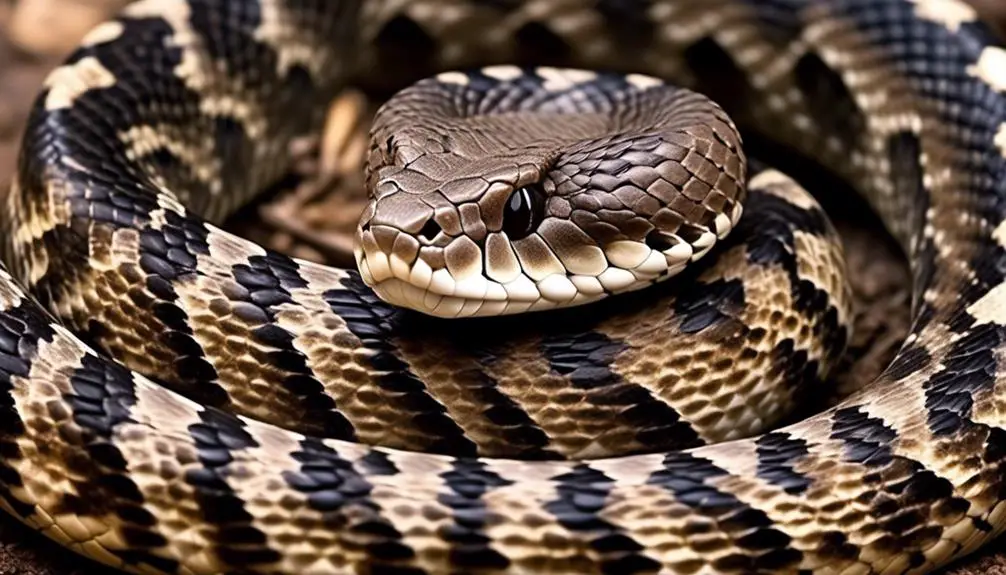
The Querétaro dusky rattlesnake, a venomous pit viper found in central Mexico, is known for its preference for rocky habitats and its hemotoxic venom that targets the circulatory system. This species, scientifically known as Crotalus aquilus, is a relatively small rattlesnake, reaching lengths of only about 2.5 feet. It has a slender body with dark gray or brown coloration, adorned with distinct crossbands that vary in intensity from individual to individual. The scales on its back are keeled, providing additional grip and allowing it to navigate the rocky terrain with ease.
The hemotoxic venom of the Querétaro dusky rattlesnake is composed of a complex mixture of enzymes and toxins. When injected into its prey or a potential threat, the venom rapidly attacks the circulatory system, leading to the destruction of red blood cells, disruption of blood clotting mechanisms, and tissue damage. The venom also contains proteins that can cause pain, swelling, and inflammation at the site of the bite.
Although the Querétaro dusky rattlesnake possesses potent venom, it generally exhibits a shy and non-aggressive nature. It prefers to retreat and hide when confronted, relying on its camouflage and the warning rattle of its tail to deter potential threats. However, if cornered or provoked, it can deliver a quick strike, injecting its venom through its hollow fangs.
To avoid encounters with this venomous snake, it’s crucial to exercise caution when exploring rocky habitats in central Mexico. Watch your step, listen for the distinctive rattle, and give the Querétaro dusky rattlesnake the space it needs to thrive in its natural environment.
Banded Rock Rattlesnake
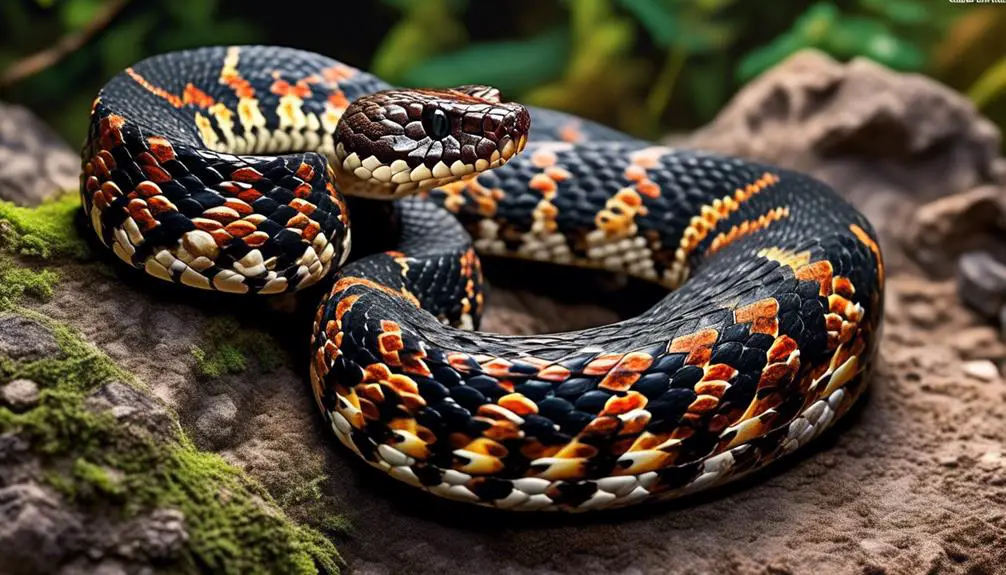
As we turn our attention to the banded rock rattlesnake, let’s explore another venomous pit viper found in Mexico that shares similarities with the Querétaro dusky rattlesnake.
The banded rock rattlesnake, scientifically known as Crotalus lepidus klauberi, is a subspecies of the rock rattlesnake and is native to the northern states of Mexico. Like the Querétaro dusky rattlesnake, the banded rock rattlesnake prefers rocky habitats and can often be found hiding in rock crevices. It’s a medium-sized snake, growing up to 3 feet in length, and has a distinct banded pattern on its body.
One of the defining features of the banded rock rattlesnake is its hemotoxic venom, which attacks the circulatory system. This venom contains a combination of enzymes and toxins that can lead to tissue damage and internal bleeding. The banded rock rattlesnake uses its venom to immobilize its prey, which primarily consists of small rodents and lizards.
When it comes to human encounters, the banded rock rattlesnake generally prefers to avoid confrontation and will only strike if it feels threatened or cornered. However, it’s important to exercise caution and give these snakes a wide berth to avoid any potential bites. If bitten, immediate medical attention is crucial, as the venom can cause severe pain, swelling, and tissue damage.
Coral Snake
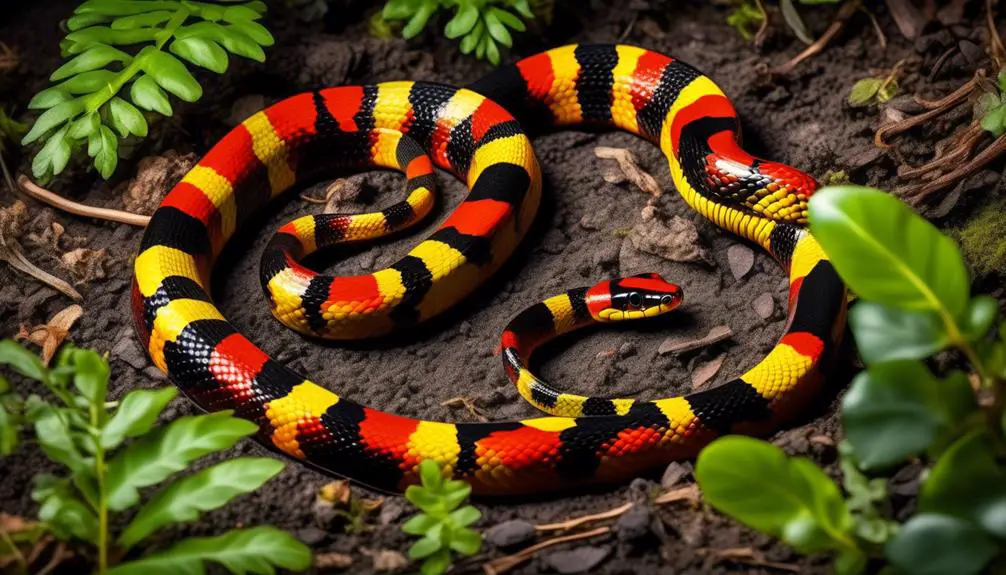
With its vibrantly colored body banded in red, yellow, and black, the Coral snake is one of the most deadly snakes in Mexico and the world. This highly venomous creature possesses neurotoxic venom that causes rapid paralysis and respiratory failure. Although it’s considered less dangerous than rattlesnakes due to its weaker teeth and less effective poison-delivery system, the Coral snake should still be approached with caution.
These snakes are fairly reclusive and prefer to hide under rocks and leaves in forests and woodland areas. The Coral snake’s distinctive coloration serves as a warning to potential predators, as it signals the snake’s deadly nature. It’s important to note that the Coral snake’s venom isn’t as potent as that of some other venomous snakes, but its venom can still be lethal. If bitten by a Coral snake, seek immediate medical attention as the effects of its neurotoxic venom can be life-threatening.
Fer-de-lance
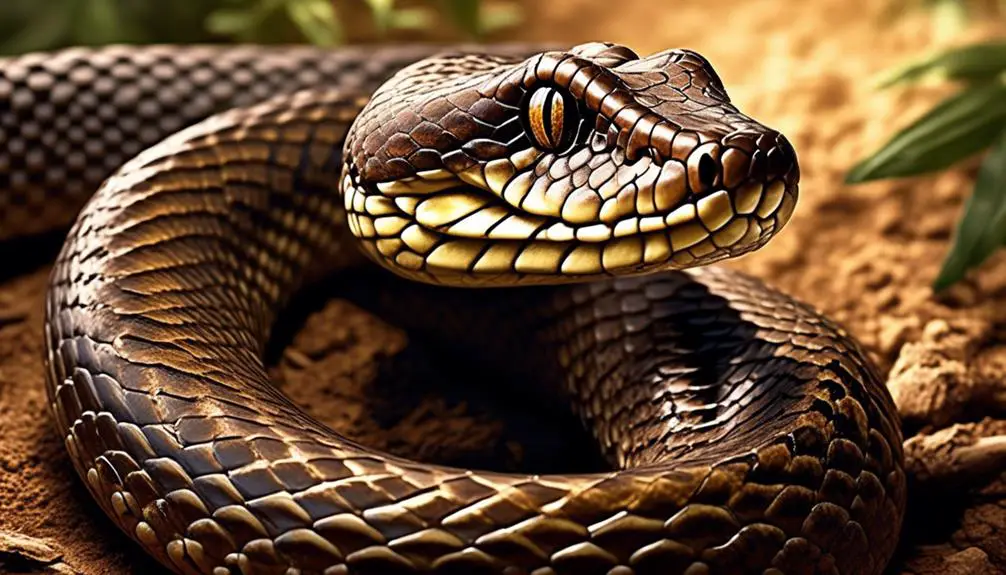
Moving on to the next venomous snake species in Mexico, let’s now focus our attention on the Fer-de-lance. This highly venomous pit viper, also known as the Bothrops asper, is native to South and Central America. In Mexico, it can be found in lowland habitats such as forests and riverbanks in the southern and eastern regions. The Fer-de-lance is known for its aggressive behavior and is not afraid of humans.
Here is a table highlighting some key characteristics of the Fer-de-lance:
| Characteristic | Description |
|---|---|
| Appearance | Olive green color with dark markings |
| Size | Can grow between 5ft and 9ft long |
| Venom | Hemotoxic venom that causes necrosis and internal bleeding |
| Habitat | Lowland habitats such as forests and riverbanks |
| Behavior | Aggressive and not afraid of humans |
The Fer-de-lance’s hemotoxic venom attacks the circulatory system, leading to necrosis and internal bleeding. It is crucial to exercise caution when encountering this snake, as its bite can have severe consequences. In case of a bite, immediate medical attention is required. Remember to always stay alert and avoid any unnecessary interactions with these dangerous reptiles.
Yellow-Bellied Sea Snake
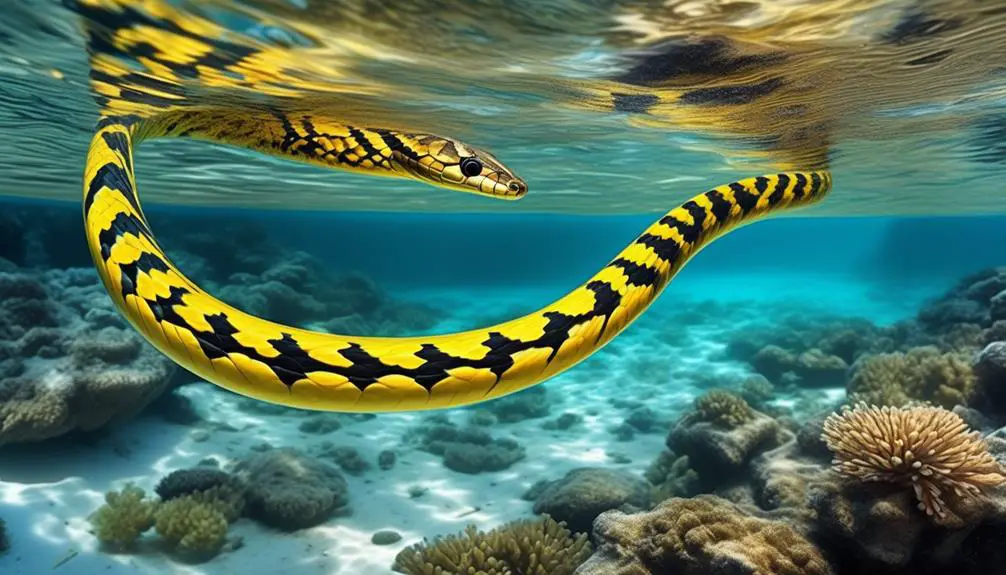
The Yellow-Bellied Sea Snake is a fascinating creature found swimming in warm waters off the coast of Mexico. These snakes are short and slender, with brown upper bodies and distinctive yellow bellies. They’ve the ability to stay underwater for up to 3 hours and feed on small fishes and eels by injecting neurotoxic venom.
Despite their timid nature and avoidance of contact with humans, it’s important to be aware of their presence and exercise caution when encountering them in their natural habitat.
Habitat and Behavior
The yellow-bellied sea snake, also known as the pelagic sea snake, can be found swimming in warm waters off the coast of Mexico. These snakes are short and slender, with brown upper bodies and distinctive yellow bellies. They’ve adapted to their marine environment and can stay underwater for up to 3 hours.
Yellow-bellied sea snakes primarily feed on small fishes and eels, injecting them with neurotoxic venom. Despite their venomous nature, they’re timid creatures that avoid contact with humans. They’re rarely seen near shorelines and are typically found far out at sea.
Understanding their habitat and behavior can help prevent unnecessary encounters with these elusive creatures.
Venom and Effects
The venom of the yellow-bellied sea snake, also known as the pelagic sea snake, contains a powerful neurotoxin. This neurotoxin attacks the nervous system, causing paralysis and eventually leading to respiratory failure. When the yellow-bellied sea snake injects its venom into its prey, the neurotoxin quickly takes effect, immobilizing the prey and making it easier for the snake to consume.
In humans, a bite from this snake can cause symptoms such as muscle weakness, blurred vision, difficulty breathing, and even death in severe cases. It’s important to note that these snakes are generally timid creatures and will avoid contact with humans if given the opportunity.
However, it’s crucial to exercise caution and seek immediate medical attention if bitten by a yellow-bellied sea snake.
Twin-Spotted Rattlesnake
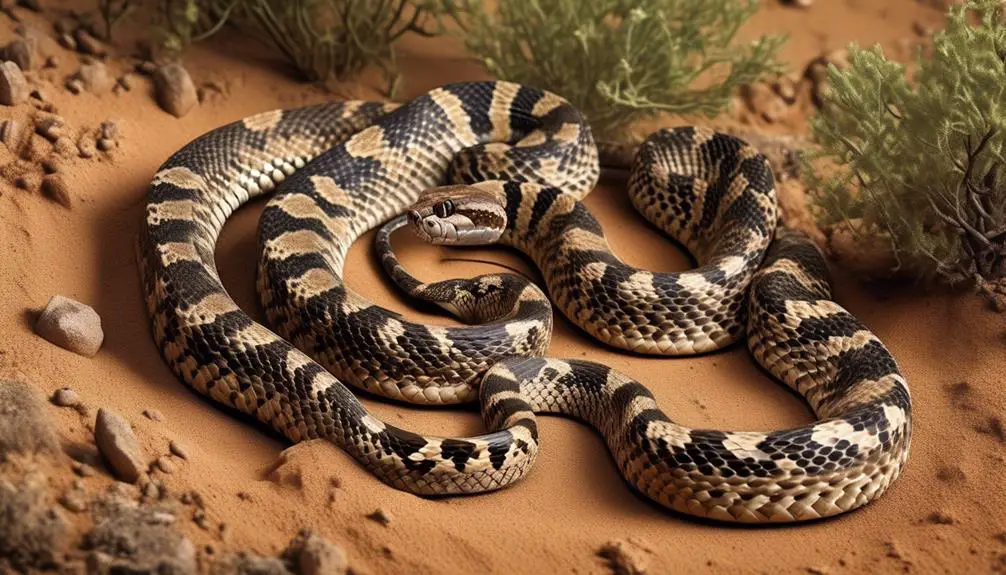
The Twin-Spotted Rattlesnake, a relatively small and slender venomous pit viper native to southwestern USA and northern Mexico, is distinguished by two lines of dark spots on its body. This species, also known as the Crotalus pricei, can reach lengths of up to 3 feet. It typically inhabits high-elevation forests in mountainous regions, where it can be found hiding under rocks, logs, and leaf litter.
The Twin-Spotted Rattlesnake possesses a potent venom that primarily consists of hemotoxins. These hemotoxins target the circulatory system, leading to symptoms such as tissue damage, internal bleeding, and organ failure. Bites from this snake can be life-threatening and require immediate medical attention.
In terms of behavior, the Twin-Spotted Rattlesnake is generally shy and non-aggressive. However, when provoked or threatened, it will defend itself by shaking its distinctive rattle and striking with its venomous fangs. It primarily feeds on small mammals, such as rodents, using its venom to immobilize and subdue its prey.
If you encounter a Twin-Spotted Rattlesnake in the wild, it’s important to maintain a safe distance and avoid any sudden movements. Remember that these snakes play a vital role in their ecosystems by controlling rodent populations. By respecting their space and appreciating their place in nature, we can coexist with these fascinating creatures.
Mojave Green
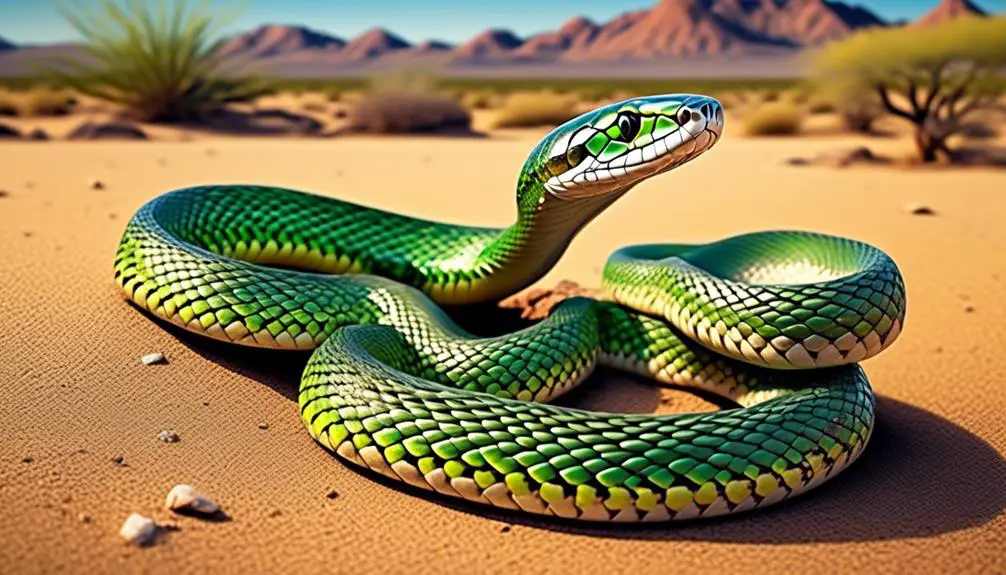
Now let’s turn our attention to the Mojave Green, a venomous pit viper that can be found in the southwestern USA and northwestern Mexico.
With its light green color and dark diamond-shaped patterns, this snake can grow up to 4 feet long.
Its neurotoxic venom poses a significant threat to the nervous system and can potentially lead to respiratory failure.
The Mojave Green typically inhabits desert regions and sandy areas, so caution must be exercised when encountering this dangerous snake.
Venomous Characteristics Explained
Occasionally encountered in the deserts of southwestern USA and northwestern Mexico, the Mojave green is a venomous pit viper with distinctive light green coloration and dark diamond-shaped patterns. This snake can grow up to 4 feet long. Its venom is neurotoxic, meaning it affects the nervous system, and can potentially cause respiratory failure.
The Mojave green is found in desert regions and sandy areas, where it blends in with its surroundings. It possesses fangs that deliver its venom, which acts on the victim’s nervous system, causing paralysis and potentially death.
It’s important to exercise caution and avoid any encounters with the Mojave green, as its venomous characteristics make it a dangerous snake to come into contact with.
Habitat and Distribution
After discussing the venomous characteristics of the Mojave green, it’s important to understand its habitat and distribution in order to better avoid encounters with this dangerous snake.
The Mojave green, a venomous pit viper, can be found in southwestern USA and northwestern Mexico. It prefers desert regions and sandy areas for its habitat. You may find this snake in sandy washes, creosote flats, and Joshua tree forests. The Mojave green is well adapted to these arid environments, blending in with its light green color and dark diamond-shaped patterns.
It can grow up to 4 feet long and possesses neurotoxic venom that affects the nervous system, potentially leading to respiratory failure. Being aware of the Mojave green’s preferred habitat can help you take necessary precautions to avoid encounters with this venomous snake.
Potential Dangers and Risks
The Mojave green, one of the most venomous snakes in Mexico, poses significant dangers and risks to those who encounter it. This snake, also known as the Mojave rattlesnake, is a venomous pit viper found in the southwestern USA and northwestern Mexico.
It can grow up to 4 feet long and has a light green color with dark diamond-shaped patterns. The venom of the Mojave green is neurotoxic, meaning it affects the nervous system and can cause respiratory failure. This makes it a highly dangerous snake to come into contact with.
It’s commonly found in desert regions and sandy areas, so it’s important to exercise caution when exploring these environments to avoid potential encounters with this venomous snake.
Most Poisonous Snake in Mexico
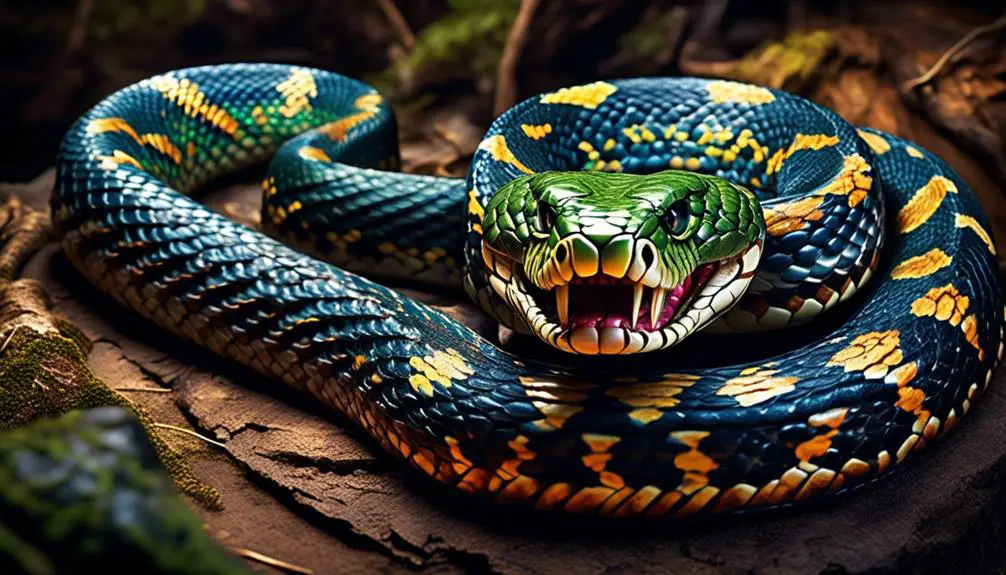
The Mojave green snake is widely regarded as the most poisonous snake in Mexico, known for its potent venom and potentially life-threatening effects. This venomous pit viper, also known as Crotalus scutulatus, is found in the southwestern United States and northwestern Mexico. It’s characterized by its light green color with dark diamond-shaped patterns and can grow up to 4 feet long. The Mojave green snake prefers desert regions and sandy areas as its habitat.
The venom of the Mojave green snake is neurotoxic, meaning it affects the nervous system. It contains a potent mix of toxins that can cause respiratory failure in its victims. The effects of its venom can be devastating, and prompt medical attention is crucial in the event of a bite. Despite its reputation as the most poisonous snake in Mexico, it’s important to note that fatalities resulting from Mojave green snake bites are relatively rare, thanks to the availability of antivenom.
While the Mojave green snake holds the title for the most poisonous snake in Mexico, it’s worth mentioning that the country is home to a total of seven types of poisonous snakes. These include pit vipers like the Querétaro dusky rattlesnake and banded rock rattlesnake, as well as other venomous snakes like the fer-de-lance. Mexico also has water snakes such as the yellow-bellied sea snake. It’s important to exercise caution and be aware of these potentially dangerous creatures when venturing into their natural habitats.
Number of Poisonous Snakes in Mexico

Continuing our exploration of Mexico’s dangerous snakes, let’s now turn our attention to the number of poisonous snakes present in the country’s diverse ecosystems.
Mexico is home to a total of seven types of poisonous snakes, making it an important habitat for these venomous creatures. The majority of these snakes belong to the pit viper family, including the Querétaro dusky rattlesnake and the banded rock rattlesnake. These venomous pit vipers are found in various regions of Mexico, with the Querétaro dusky rattlesnake inhabiting the central parts of the country, while the banded rock rattlesnake is native to the northern states. Both of these snakes prefer rocky habitats and often hide in rock crevices. Their venom is hemotoxic, attacking the circulatory system and causing severe damage.
In addition to the pit vipers, Mexico is also home to other venomous snakes such as the fer-de-lance, a highly venomous pit viper native to South and Central America. This snake is found in lowland habitats, including forests and riverbanks in southern and eastern Mexico. Its venom is hemotoxic, causing necrosis and internal bleeding.
Furthermore, Mexico is also home to water snakes like the yellow-bellied sea snake, which is found swimming in warm waters off the coast. These timid creatures have neurotoxic venom and feed on small fishes and eels.
With a total count of seven poisonous snakes, Mexico’s diverse ecosystems provide a significant habitat for these venomous creatures. It’s crucial for residents and visitors to be aware of the presence of these snakes and take necessary precautions while exploring the country’s natural wonders.
Majority Are Pitvipers
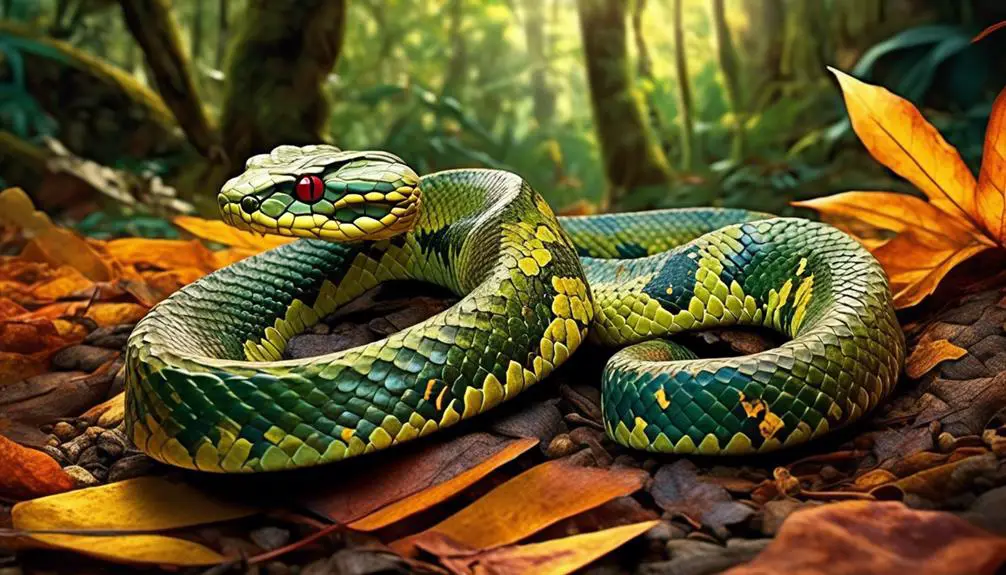
When it comes to venomous snakes in Mexico, the majority belong to the pitviper family. Pitvipers are characterized by their heat-sensing pits located between their nostrils and eyes, which enable them to detect prey and predators.
Some venomous pitviper species found in Mexico include the Querétaro dusky rattlesnake and the banded rock rattlesnake, both of which prefer rocky habitats and possess hemotoxic venom that affects the circulatory system.
Understanding the characteristics, habitats, and behavior of these pitvipers is crucial for staying safe in snake-prone areas of Mexico.
Pitviper Characteristics
Pitvipers, comprising the majority of venomous snakes found in Mexico, possess distinct characteristics that set them apart from other snake species. These snakes are known for their triangular-shaped heads, vertical pupils, and heat-sensing pits located between their eyes and nostrils. Pitvipers also have long fangs that fold back when not in use, allowing them to strike efficiently and deliver venom deep into their prey. Their venom is primarily hemotoxic, meaning it attacks the circulatory system, causing tissue damage and internal bleeding. Some pitvipers, like the Querétaro dusky rattlesnake and the Banded rock rattlesnake, prefer rocky habitats and hide in rock crevices. Understanding these unique characteristics is crucial for identifying and avoiding encounters with these venomous snakes.
| Pitviper Characteristics | |
|---|---|
| Triangular-shaped head | |
| Vertical pupils | |
| Heat-sensing pits | |
| Long fangs | |
| Hemotoxic venom |
Venomous Pitviper Species
To further explore the topic of venomous pitviper species, it’s important to understand the diverse range of snakes found in Mexico. Mexico is home to several venomous pitvipers, with the majority belonging to this family.
The Querétaro dusky rattlesnake and the Banded rock rattlesnake are two venomous pitvipers that can be found in Mexico. The Querétaro dusky rattlesnake is native to central Mexico, while the Banded rock rattlesnake is found in the northern states. Both of these snakes prefer rocky habitats and can often be found hiding in rock crevices.
They possess hemotoxic venom that attacks the circulatory system. It’s crucial to exercise caution when encountering these venomous pitvipers in Mexico.
Pitviper Habitats and Behavior
The diverse venomous pitviper species found in Mexico inhabit a range of habitats and exhibit distinct behaviors. Here is a table summarizing some of the pitvipers and their characteristics:
| Pitviper Species | Habitat | Behavior |
|---|---|---|
| Querétaro dusky rattlesnake | Central Mexico | Prefers rocky habitats and hides in rock crevices. Has hemotoxic venom that attacks the circulatory system. |
| Banded rock rattlesnake | Northern states of Mexico | Native to rocky habitats and also hides in rock crevices. Possesses hemotoxic venom that attacks the circulatory system. |
| Fer-de-lance | Southern and eastern Mexico | Found in lowland habitats such as forests and riverbanks. Exhibits aggressive behavior and is not afraid of humans. Its venom is hemotoxic, causing necrosis and internal bleeding. |
| Coral snake | Forests and woodland areas | Fairly reclusive and hides under rocks and leaves. Has neurotoxic venom that causes rapid paralysis and respiratory failure. Considered less dangerous than rattlesnakes due to weaker teeth and a less effective poison-delivery system. |
| Yellow-bellied sea snake | Warm waters off the coast of Mexico | Found swimming in the ocean and avoids contact with humans. Injects neurotoxic venom while feeding on small fishes and eels. |
| Twin-spotted rattlesnake | Mountainous regions in southwestern USA and northern Mexico | Populates high-elevation forests and exhibits hemotoxic venom that attacks the circulatory system. |
| Mojave green | Desert regions and sandy areas in Mexico | Found in desert regions and sandy areas. Possesses neurotoxic venom that affects the nervous system and can cause respiratory failure. |
These pitvipers have adapted to their specific habitats and exhibit behaviors that help them survive and thrive. Understanding their habitats and behaviors can be crucial for both snake enthusiasts and individuals living in areas where these venomous species are present.
Other Venomous Snakes

Mexico is home to various venomous snakes apart from the well-known pitvipers and coral snakes. These include the Querétaro dusky rattlesnake and the Banded rock rattlesnake.
The Querétaro dusky rattlesnake is found in central Mexico, while the Banded rock rattlesnake is native to the northern states. Both of these venomous pit vipers prefer rocky habitats and often hide in rock crevices. They possess hemotoxic venom that attacks the circulatory system.
Another venomous snake found in Mexico is the coral snake. Known as one of the most deadly snakes in both Mexico and the world, coral snakes have vibrant bodies banded in red, yellow, and black. Their neurotoxic venom causes rapid paralysis and respiratory failure. However, they’re considered less dangerous than rattlesnakes due to their weaker teeth and less effective poison-delivery system. Coral snakes are fairly reclusive creatures that hide under rocks and leaves in forests and woodland areas.
The fer-de-lance is another venomous snake native to South and Central America, including southern and eastern Mexico. This highly venomous pit viper can grow between 5ft and 9ft long and is olive green with dark markings. Fer-de-lance snakes aren’t afraid of humans and exhibit aggressive behavior. Their hemotoxic venom causes necrosis and internal bleeding.
Mexico is also home to the yellow-bellied sea snake, which is found swimming in warm waters off the coast. These short and slender snakes have brown upper bodies and yellow bellies. They can stay underwater for up to 3 hours and feed on small fishes and eels by injecting neurotoxic venom. However, yellow-bellied sea snakes are timid creatures that avoid contact with humans.
The twin-spotted rattlesnake is a relatively small and slender venomous pit viper native to southwestern USA and northern Mexico. It’s distinguished by two lines of dark spots on its body and populates high-elevation forests in mountainous regions. The hemotoxins in its venom attack the circulatory system and can be life-threatening.
Finally, the Mojave green is a venomous pit viper found in southwestern USA and northwestern Mexico. It has a light green color with dark diamond-shaped patterns and can grow up to 4 feet long. The neurotoxic venom of the Mojave green affects the nervous system and can cause respiratory failure. These snakes are typically found in desert regions and sandy areas.
In total, Mexico is home to seven types of venomous snakes, including the pit vipers such as the Querétaro dusky rattlesnake and banded rock rattlesnake, as well as the fer-de-lance. Additionally, water snakes like the yellow-bellied sea snake can also be found. It’s important to be aware of these venomous snakes and take precautions when exploring their habitats.
Water Snakes
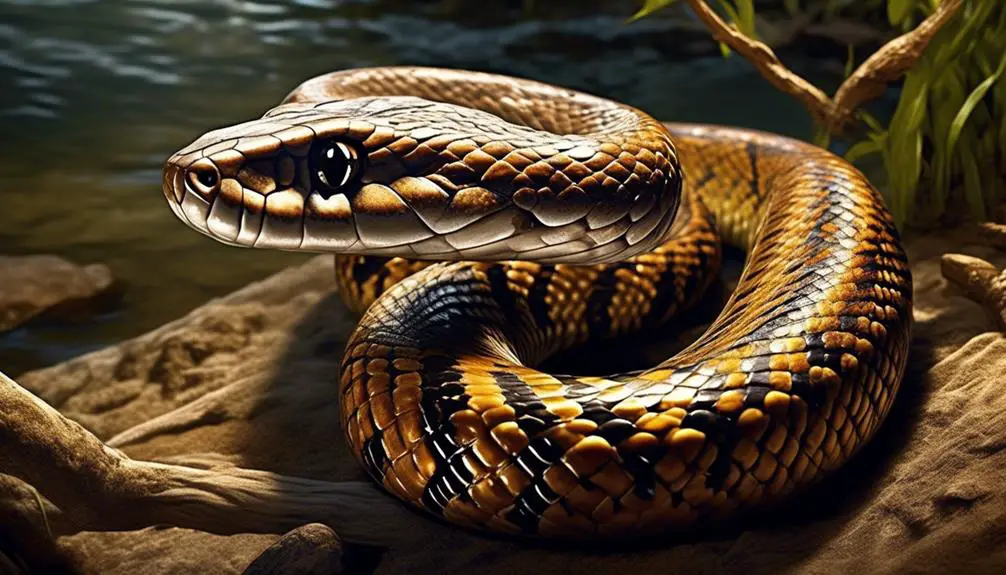
After exploring the various venomous snakes found in Mexico, it is now important to shift our focus to the water snakes that inhabit the coastal areas of this diverse country. These water snakes are adapted to survive and thrive in aquatic environments, making them unique and fascinating creatures. To help you understand more about these snakes, here is a table highlighting some of the most notable water snakes in Mexico:
| Snake Name | Description |
|---|---|
| Yellow-bellied sea snake | Found swimming in warm waters off the coast of Mexico. They have short, slender bodies and yellow bellies. They can stay underwater for up to 3 hours and feed on small fishes and eels by injecting neurotoxic venom. Despite their venomous nature, yellow-bellied sea snakes are timid creatures that avoid contact with humans. |
| Mexican black-headed snake | These snakes are native to the coastal regions of Mexico. They have black heads and slender bodies, allowing them to move swiftly through the water. While they are not venomous, they are skilled hunters and feed on small fish and amphibians. |
| Olive sea snake | Olive sea snakes have adapted to life in the ocean, with their paddle-like tails and streamlined bodies. They are found in the warm waters of the Gulf of California and the Pacific coast of Mexico. Their venom is potent, primarily affecting the nervous system, and they are known to be highly venomous. However, they are not aggressive and will only bite if provoked. |
Water snakes play a crucial role in the coastal ecosystems of Mexico. They help control populations of fish and other aquatic species, contributing to the overall balance of these fragile ecosystems. While some water snakes may possess venom, it is important to remember that they are vital components of the natural world and should be respected and admired from a safe distance.
Total Count of Land and Water Snakes

With a diverse array of land and water habitats, Mexico is home to a rich variety of snake species, making for a significant total count of both land and water snakes. Mexico boasts a total of seven types of poisonous snakes, most of which are pit vipers. These include the venomous Querétaro dusky rattlesnake and the banded rock rattlesnake, both found in different regions of Mexico.
The fer-de-lance, a highly venomous pit viper native to South and Central America, is also present in the country. Additionally, Mexico is home to water snakes such as the yellow-bellied sea snake, which can be found swimming in warm coastal waters.
In terms of land snakes, Mexico is inhabited by the twin-spotted rattlesnake, known for its relatively small and slender build and distinctive dark spots. Another venomous pit viper, the Mojave green, can also be found in Mexico’s desert regions.
With these various species of land and water snakes, Mexico’s total count adds to the country’s reputation as a habitat for diverse and dangerous snakes.

Erzsebet Frey (Eli Frey) is an ecologist and online entrepreneur with a Master of Science in Ecology from the University of Belgrade. Originally from Serbia, she has lived in Sri Lanka since 2017. Eli has worked internationally in countries like Oman, Brazil, Germany, and Sri Lanka. In 2018, she expanded into SEO and blogging, completing courses from UC Davis and Edinburgh. Eli has founded multiple websites focused on biology, ecology, environmental science, sustainable and simple living, and outdoor activities. She enjoys creating nature and simple living videos on YouTube and participates in speleology, diving, and hiking.

